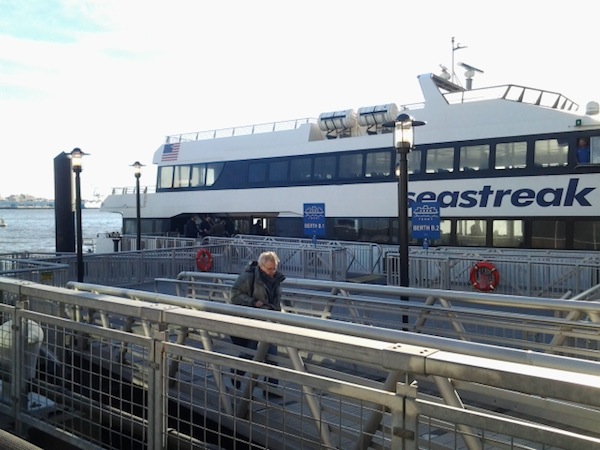
BY KAITLYN MEADE | Danielle Moir checked the news at her Battery Park City home on Wed., Jan 9, before leaving with her 6-year-old son for an appointment Uptown. It was a routine check for traffic delays, so she was not expecting to hear of a collision at nearby Pier 11.
“All I heard was ‘hard landing.’ I thought it was the helicopter,” said Moir of the helipad also located at the piers. When they drove by at about 8:40 a.m., the boat looked undamaged and no one had yet exited onto the pier. “But as we drove Uptown, there were ambulances and police cars and fire trucks all heading Downtown.”
It was not a helicopter, but rather a high speed ferry that missed its slip and crashed into Pier 11 at 10-12 knots, too fast for a craft that should have been slowing down to dock. The Seastreak ferry left Atlantic Highlands in New Jersey at 8 a.m. on Jan. 9 and barreled into the pier at about 8:45 a.m. causing damage to the ship and pitching people across the deck and down stairwells, injuring over 50 of them.
Several passengers were rushed to nearby Bellevue and New York Downtown Hospital in neck braces. There have been no fatalities reported, but one passenger was in critical condition after the accident
The next day, as Moir waited for the Ikea ferry on Pier 11, she gazed toward the notice posted on Slip D that read ‘Out of Service. Ask an attendant.’
Seastreak, conducts routine commutes across the Hudson to the Wall Street pier. Officials say there were 326 passengers and five crew members aboard the ship, operated by Senior Captain Jason Reimer, 36. Reimer, during a three hour interview, told National Transportation Safety Board investigators that he tried to reverse the vessel, but mechanical failures prevented him.
“Something like that brings it home, how close we come every day to calamity,” said Sam Terrell, who has made the Hudson River commute on the Seastreak for 15 years.
For him, it was one of several events that have forced him to “stop and think” recently. His town was flooded by Hurricane Sandy in October, though the water only came halfway up the driveway of his home. And in 2001, his office was located in the World Trade Center. He was slated to go up to a conference on the top floor on September 11. But he skipped it that fateful morning, which very well could have saved his life.
“My friends told me I should play the lottery,” he joked, but added that, “It gives you pause.”
“I usually stand on the stairs by the door,” said another commuter, also named Sam, waiting for the ferry service at 3 p.m. on Jan. 10. He added that the next morning “everyone was far more cautious. Not many people were standing up or crowding the doors.”
He said he had a friend who was on the out-of-control ferry, an emergency medical technician that was thankfully only “shaken up,” and was able to assist others who were injured that morning.
The National Transportation Safety Board is in the midst of an ongoing investigation into what caused the crash. On Jan. 17, N.T.S.B. reported that they had conducted a series of tests on equipment, including tests of the steering and propeller systems. Interviews of the ship’s engineers and passengers are ongoing.
This is not the first Seastreak ferry accident. The Associated Press reported that there was an incident in 2010 in which the Seastreak Wall Street damaged its hull when it smashed into fender piles while pulling up to the dock. There was also an incident in 2009, according to CBS New York, in which the ferry hit a pier at E. 35th St., gouging a hole in the hull.

































